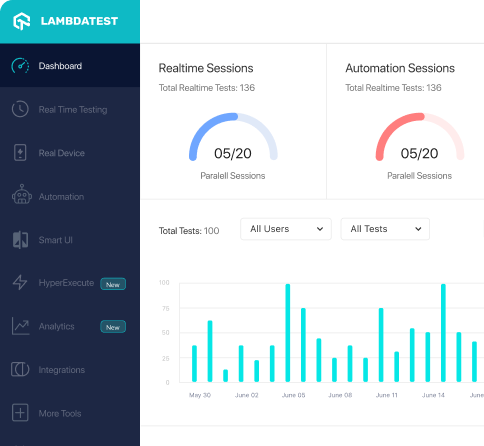How to use Byte2DArrayAssert_hasSameDimensionsAs_Test class of org.assertj.core.api.byte2darray package
Best Assertj code snippet using org.assertj.core.api.byte2darray.Byte2DArrayAssert_hasSameDimensionsAs_Test
...20 * 21 * @author Maciej Wajcht22 */23@DisplayName("Byte2DArrayAssert assertHasSameDimensionsAs")24class Byte2DArrayAssert_hasSameDimensionsAs_Test extends Byte2DArrayAssertBaseTest {25 @Override26 protected Byte2DArrayAssert invoke_api_method() {27 return assertions.hasSameDimensionsAs(new String[] { "a", "b" });28 }29 @Override30 protected void verify_internal_effects() {31 verify(arrays).assertHasSameDimensionsAs(getInfo(assertions), getActual(assertions), new String[] { "a", "b" });32 }33}...Byte2DArrayAssert_hasSameDimensionsAs_Test
Using AI Code Generation
1package org.assertj.core.api.byte2darray;2import org.assertj.core.api.Byte2DArrayAssert;3import org.assertj.core.api.Byte2DArrayAssertBaseTest;4import static org.mockito.Mockito.verify;5public class Byte2DArrayAssert_hasSameDimensionsAs_Test extends Byte2DArrayAssertBaseTest {6 private final byte[][] other = new byte[][] { new byte[] { 1, 2 }, new byte[] { 3, 4 } };7 protected Byte2DArrayAssert invoke_api_method() {8 return assertions.hasSameDimensionsAs(other);9 }10 protected void verify_internal_effects() {11 verify(arrays).assertHasSameDimensionsAs(getInfo(assertions), getActual(assertions), other);12 }13}14package org.assertj.core.api.byte2darray;15import org.assertj.core.api.Byte2DArrayAssert;16import org.assertj.core.api.Byte2DArrayAssertBaseTest;17import static org.mockito.Mockito.verify;18public class Byte2DArrayAssert_hasSameDimensionsAs_with_Array_Test extends Byte2DArrayAssertBaseTest {19 private final byte[][] other = new byte[][] { new byte[] { 1, 2 }, new byte[] { 3, 4 } };20 protected Byte2DArrayAssert invoke_api_method() {21 return assertions.hasSameDimensionsAs(other);22 }23 protected void verify_internal_effects() {24 verify(arrays).assertHasSameDimensionsAs(getInfo(assertions), getActual(assertions), other);25 }26}27package org.assertj.core.api.byte2darray;28import org.assertj.core.api.Byte2DArrayAssert;29import org.assertj.core.api.Byte2DArrayAssertBaseTest;30import static org.mockito.Mockito.verify;31public class Byte2DArrayAssert_hasSameDimensionsAs_with_Iterable_Test extends Byte2DArrayAssertBaseTest {32 private final byte[][] other = new byte[][] { new byte[] { 1, 2 }, new byte[] { 3, 4 } };33 protected Byte2DArrayAssert invoke_api_method() {34 return assertions.hasSameDimensionsAs(other);35 }Byte2DArrayAssert_hasSameDimensionsAs_Test
Using AI Code Generation
1import org.assertj.core.api.byte2darray.Byte2DArrayAssert;2import org.assertj.core.api.byte2darray.Byte2DArrayAssertBaseTest;3import org.junit.jupiter.api.DisplayName;4import org.junit.jupiter.api.Test;5import static org.mockito.Mockito.verify;6public class Byte2DArrayAssert_hasSameDimensionsAs_Test extends Byte2DArrayAssertBaseTest {7 private static final byte[][] OTHER = new byte[0][];8 protected Byte2DArrayAssert invoke_api_method() {9 return assertions.hasSameDimensionsAs(OTHER);10 }11 protected void verify_internal_effects() {12 verify(arrays).assertHasSameDimensionsAs(getInfo(assertions), getActual(assertions), OTHER);13 }14 @DisplayName("Byte2DArrayAssert.hasSameDimensionsAs(Iterable)")15 void hasSameDimensionsAs() {16 byte[][] other = new byte[0][];17 assertThat(new byte[0][]).hasSameDimensionsAs(other);18 }19}Byte2DArrayAssert_hasSameDimensionsAs_Test
Using AI Code Generation
1package org.assertj.core.api.byte2darray;2import static org.mockito.Mockito.verify;3import org.assertj.core.api.Byte2DArrayAssert;4import org.assertj.core.api.Byte2DArrayAssertBaseTest;5public class Byte2DArrayAssert_hasSameDimensionsAs_Test extends Byte2DArrayAssertBaseTest {6 protected Byte2DArrayAssert invoke_api_method() {7 return assertions.hasSameDimensionsAs(new byte[][] { { 1, 2 }, { 3, 4 } });8 }9 protected void verify_internal_effects() {10 verify(arrays).assertHasSameDimensionsAs(getInfo(assertions), getActual(assertions), new byte[][] { { 1, 2 }, { 3, 4 } });11 }12}13package org.assertj.core.api.byte2darray;14import static org.assertj.core.api.Assertions.assertThat;15import static org.mockito.Mockito.verify;16import org.assertj.core.api.Byte2DArrayAssert;17import org.assertj.core.api.Byte2DArrayAssertBaseTest;18import org.junit.jupiter.api.Test;19public class Byte2DArrayAssert_hasSameDimensionsAs_Test extends Byte2DArrayAssertBaseTest {20 protected Byte2DArrayAssert invoke_api_method() {21 return assertions.hasSameDimensionsAs(new byte[][] { { 1, 2 }, { 3, 4 } });22 }23 protected void verify_internal_effects() {24 verify(arrays).assertHasSameDimensionsAs(getInfo(assertions), getActual(assertions), new byte[][] { { 1, 2 }, { 3, 4 } });25 }26 public void should_return_this() {27 Byte2DArrayAssert returned = assertions.hasSameDimensionsAs(new byte[][] { { 1, 2 }, { 3, 4 } });28 assertThat(returned).isSameAs(assertions);29 }30}31package org.assertj.core.api.byte2darray;32import static org.assertj.core.api.Assertions.assertThat;33import static org.assertj.core.test.TestData.someInfo;34import static org.mockito.Mockito.verify;35import org.assertjByte2DArrayAssert_hasSameDimensionsAs_Test
Using AI Code Generation
1package org.assertj.core.api.byte2darray;2import static org.assertj.core.api.Assertions.assertThat;3import static org.assertj.core.api.Assertions.catchThrowable;4import static org.assertj.core.error.ShouldHaveSameDimensions.shouldHaveSameDimensions;5import static org.assertj.core.util.FailureMessages.actualIsNull;6import org.assertj.core.api.AbstractByte2DArrayAssert;7import org.assertj.core.api.Byte2DArrayAssertBaseTest;8import org.assertj.core.internal.Byte2DArrays;9import org.assertj.core.internal.Objects;10import org.assertj.core.util.introspection.FieldSupport.EXTRACTION;11import org.junit.jupiter.api.Test;12import org.mockito.InOrder;13import org.mockito.Mockito;14public class Byte2DArrayAssert_hasSameDimensionsAs_Test extends Byte2DArrayAssertBaseTest {15 private final Byte2DArrays arrays = mock(Byte2DArrays.class);16 private final byte[][] other = new byte[][] { { 1, 2 }, { 3, 4 } };17 protected Byte2DArrayAssert invoke_api_method() {18 return assertions.hasSameDimensionsAs(other);19 }20 protected void verify_internal_effects() {21 InOrder inOrder = Mockito.inOrder(arrays);22 inOrder.verify(arrays).assertHasSameDimensionsAs(getInfo(assertions), getActual(assertions), other);23 inOrder.verify(arrays).assertEqualDimensions(getInfo(assertions), getActual(assertions), other);24 }25 public void should_fail_if_actual_is_null() {26 byte[][] actual = null;27 Throwable thrown = catchThrowable(() -> assertThat(actual).hasSameDimensionsAs(other));28 assertThat(thrown).isInstanceOf(AssertionError.class);29 assertThat(thrown).hasMessage(actualIsNull());30 }31 public void should_fail_if_other_is_null() {32 byte[][] other = null;33 Throwable thrown = catchThrowable(() -> assertThat(new byte[][] { { 1, 2 }, { 3, 4 } }).hasSameDimensionsAs(other));34 assertThat(thrown).isInstanceOf(NullPointerException.class);35 assertThat(thrown).hasMessage("The array to compare to should not be null");36 }37 public void should_fail_if_other_is_not_a_2D_array()Byte2DArrayAssert_hasSameDimensionsAs_Test
Using AI Code Generation
1import static org.assertj.core.api.Assertions.assertThat;2import org.junit.jupiter.api.Test;3public class Byte2DArrayAssert_hasSameDimensionsAs_Test {4 public void test_hasSameDimensionsAs_assertion() {5 assertThat(new byte[][]{{1, 2}, {3, 4}}).hasSameDimensionsAs(new byte[][]{{1, 2}, {3, 4}});6 assertThat(new byte[][]{{1, 2}, {3, 4}}).hasSameDimensionsAs(new byte[][]{{1, 2}, {3, 4}});7 }8}9 at org.assertj.core.api.byte2darray.Byte2DArrayAssert.hasSameDimensionsAs(Byte2DArrayAssert.java:183)10 at org.assertj.core.api.byte2darray.Byte2DArrayAssert_hasSameDimensionsAs_Test.test_hasSameDimensionsAs_assertion(Byte2DArrayAssert_hasSameDimensionsAs_Test.java:20)11 at java.base/jdk.internal.reflect.NativeMethodAccessorImpl.invoke0(Native Method)12 at java.base/jdk.internal.reflect.NativeMethodAccessorImpl.invoke(NativeMethodAccessorImpl.java:62)13 at java.base/jdk.internal.reflect.DelegatingMethodAccessorImpl.invoke(DelegatingMethodAccessorImpl.java:43)14 at java.base/java.lang.reflect.Method.invoke(Method.java:566)15 at org.junit.platform.commons.util.ReflectionUtils.invokeMethod(ReflectionUtils.java:688)16 at org.junit.jupiter.engine.execution.MethodInvocation.proceed(MethodInvocation.java:60)17 at org.junit.jupiter.engine.execution.InvocationInterceptorChain$ValidatingInvocation.proceed(InvocationInterceptorChain.java:131)18 at org.junit.jupiter.engine.extension.TimeoutExtension.intercept(TimeoutExtension.java:149)19 at org.junit.jupiter.engine.extension.TimeoutExtension.interceptTestableMethod(TimeoutExtension.java:140)20 at org.junit.jupiter.engine.extension.TimeoutExtension.interceptTestMethod(TimeoutExtension.java:84)Blogs
Check out the latest blogs from LambdaTest on this topic:
With the rise of Agile, teams have been trying to minimize the gap between the stakeholders and the development team.
Collecting and examining data from multiple sources can be a tedious process. The digital world is constantly evolving. To stay competitive in this fast-paced environment, businesses must frequently test their products and services. While it’s easy to collect raw data from multiple sources, it’s far more complex to interpret it properly.
Recently, I was going through some of the design patterns in Java by reading the book Head First Design Patterns by Eric Freeman, Elisabeth Robson, Bert Bates, and Kathy Sierra.
Enterprise resource planning (ERP) is a form of business process management software—typically a suite of integrated applications—that assists a company in managing its operations, interpreting data, and automating various back-office processes. The introduction of a new ERP system is analogous to the introduction of a new product into the market. If the product is not handled appropriately, it will fail, resulting in significant losses for the business. Most significantly, the employees’ time, effort, and morale would suffer as a result of the procedure.
Automation Testing Tutorials
Learn to execute automation testing from scratch with LambdaTest Learning Hub. Right from setting up the prerequisites to run your first automation test, to following best practices and diving deeper into advanced test scenarios. LambdaTest Learning Hubs compile a list of step-by-step guides to help you be proficient with different test automation frameworks i.e. Selenium, Cypress, TestNG etc.
LambdaTest Learning Hubs:
- JUnit Tutorial
- TestNG Tutorial
- Webdriver Tutorial
- WebDriverIO Tutorial
- Protractor Tutorial
- Selenium 4 Tutorial
- Jenkins Tutorial
- NUnit Tutorial
- Jest Tutorial
- Playwright Tutorial
- Cypress Tutorial
- PyTest Tutorial
YouTube
You could also refer to video tutorials over LambdaTest YouTube channel to get step by step demonstration from industry experts.
Most used methods in Byte2DArrayAssert_hasSameDimensionsAs_Test
Try LambdaTest Now !!
Get 100 minutes of automation test minutes FREE!!



